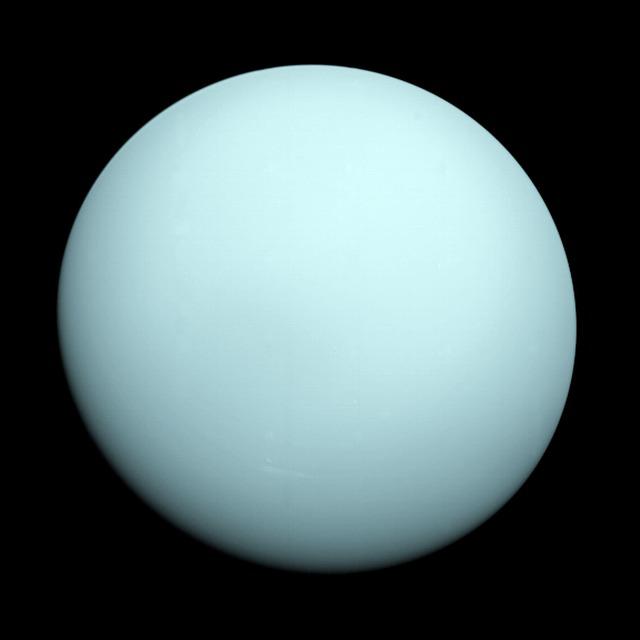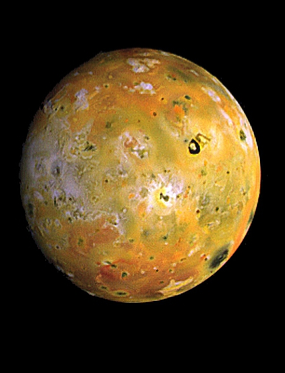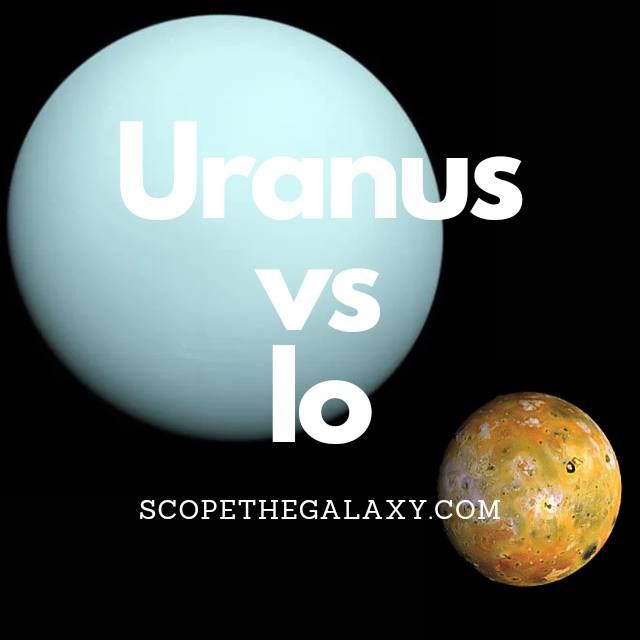*This post may contain affiliate links. This means we may make a commission if you purchase an item using one of our links*
The main differences between Uranus and Io is that Uranus is an ice based gas giant whilst Io is natural satellite that is also the most volcanically active entity, Uranus has 27 moon whilst Io has 0 entities orbiting it, Uranus is the 3rd largest planet whilst Io is the 4th largest moon and Uranus has an axial tilt of 98° whilst Io’s axial tilt is practically 0.
There are numerous other differences between the two so, continue reading for more detailed looks at each entity below along with their similarities and differences.
What Is The Planet Uranus?
Table of Contents

Uranus is the 7th farthest planet from the Sun and the 3rd largest planet in our solar system, coming in at a diameter of 50,724 km. This means that roughly 63 Earth’s could fit inside this ice giant.
In regards to why this cyan blue planet is referred to as an ice giant, it’s down to it’s composition. Uranus is made mostly of methane, ammonia and water with its atmosphere mostly consisting of hydrogen and helium, much like the Sun, and the other giant planets in our solar system.
Due to its distance from the Sun, it takes Uranus 84 years to complete one orbit our central star, whereas it’s axial rotation is much faster than even our Earth at 17 hours per rotation.
As a result of its distance from the Sun, ice based composition and faster rotation levels, Uranus is far from an ideal place to live in let alone have the potential to support life.
Its base temperature is generally a chilling -190 to -200 degrees Celsius and its rocky core, although hot, is still on the cooler side for a large planet sitting around the 5,000 degrees Celsius range.
The planet’s winds are also very fast often hitting 900 km/h, which is roughly twice that of Earth’s most powerful turbulent wind speeds.
In regards to the moons surrounding this cyan planet, we’ve discovered 27 small ones orbiting it. Furthermore, it has 13 rings surrounding it which also means Uranus has the most abundant collection of rings surrounding in our solar system, which is even more than Saturn.
One of the Uranus’ most unique features would include the manner in which it rotates around its axis. As opposed to the slightly angled rotation that the likes of Earth, Saturn and most other planets display, Uranus’ axis is positioned at a 98 degree angle.
What this means is this ice giant completes an axial rotation on its side as opposed to the relatively up straight positioning of most of the other planets in our solar system.
What Is The Moon Io?

The Moon Io – also known as Jupiter I – is the third largest of the Galilean moons, which has the closest orbit to Jupiter. It is the fourth-largest moon in our solar system by size – with a diameter of 3,643km – but has the highest density of all moons in the Milky Way.
In addition, Io has the strongest surface gravity of all moons and the least water by atomic ratio compared to any other astronomical object in our solar system.
Perhaps the most interesting feature of this lunar body is the 400 active volcanoes on its surface, which make it the most volcanically active object in the Milky Way; some of these volcanoes can exude plumes of sulfur to a height of several hundred miles.
The reason for this intense activity is the tidal heating caused by friction in the moon’s interior. Thanks to Io’s proximity to Jupiter, it finds itself caught between the gravity of its planet plus the two nearby moons – Ganymede and Europa. And this creates extreme tidal forces.
A side effect of these tidal forces is heat, which keeps most of Io’s crust in liquid form. Because of this, the surface of Io experiences a constant state of renewal; sites once home to large craters are slowly filled with molten lava and liquid rock.
While the complete makeup of Io’s surface is not yet defined, theories suggest that its main component could be sulfur and sulfur compounds because of the varied coloring. Silicate rock could also be a likely component as it would account for the high temperatures.
Io orbits Jupiter from a distance of around 422,000km, with an orbit that takes 42.5 hours to complete. Sitting 778,000,000km from the Sun, the surface temperature of this planet sits around -130 degrees Celsius. But due to the intense volcanic activity, the lava flows can reach temperatures of 1649 degrees Celsius, which is far hotter than anything on Earth.
Similarities Between Uranus And Io
Uranus and Io do share a few similar features, which in this case includes the following:
- Both are a spherical shape.
- Both have a hotter core.
- Both are part of the same solar system.
- Neither have tectonic plates.
- Both orbit another object.
Differences Between Uranus and Io
As for the differences between the two, they include the below:
- Uranus is bigger with a diameter of 50,724km compared to Io’s diameter of 3,643km.
- Uranus has a magnetosphere whilst Io does not.
- Uranus has 27 moons orbiting it whilst Io has 0 objects orbiting it.
- Io orbits Jupiter in an elliptical pattern whilst Uranus orbits the Sun in a less drastic elliptical pattern.
- Io is tidally locked to Jupiter whilst Uranus isn’t tidally locked to any other object.
- Uranus has an atmosphere composed of hydrogen, helium and methane whilst Io has a very thin sulfur dioxide based exosphere.
- Io is the most volcanically active natural satellite in the solar system.
- A day on Io takes 42 hours whilst Uranus completes a day in 17 hours.
- Io’s density is 3.53 g/cm³ whilst Uranus’ is 1.27 g/cm³.
- In regards to axial tilt, Uranus has the most drastic one at 98 degrees whilst Io is practically 0 degrees.
- Uranus has an average temperature of -190 to -200 degrees Celsius whilst Io’s average temperature is -130 degrees Celsius.
- As for mass, Io’s is 8.93 × 10^22 kg whilst Uranus’ mass is 8.681 × 10^25 kg.
- Uranus is an ice based gas giant whilst Io is a terrestrial entity.
- Uranus has the most rings amongst all the planets at 13 whilst Io has 0.
- Uranus has a gravitational strength of 8.87 m/s² whilst Io’s is 1.796 m/s².
- Uranus orbits the Sun in 84 years whilst Io orbits it in 12 years.
Summary
Although the two are part of the same solar system, there really isn’t much else that Uranus and Io share in common.
Whether it be in regards to their physical and compositional differences, mass, the number of objects that orbit them, the length of day and beyond, the two are completely different functionally.

